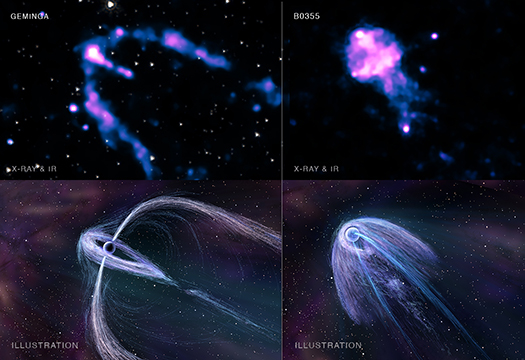Chandra Images Show That Geometry Solves a Pulsar Puzzle
NASA'S Chandra X-ray Observatory has taken deep exposures of two nearby energetic pulsars flying through the Milky Way galaxy. The shape of their X-ray emission suggests there is a geometrical explanation for puzzling differences in behavior shown by some pulsars.
Pulsars - rapidly rotating, highly magnetized, neutron stars born in supernova explosions triggered by the collapse of massive stars- were discovered 50 years ago via their pulsed, highly regular, radio emission. Pulsars produce a lighthouse-like beam of radiation that astronomers detect as pulses as the pulsar's rotation sweeps the beam across the sky.
Since their discovery, thousands of pulsars have been discovered, many of which produce beams of radio waves and gamma rays. Some pulsars show only radio pulses and others show only gamma-ray pulses. Chandra observations have revealed steady X-ray emission from extensive clouds of high-energy particles, called pulsar wind nebulas, associated with both types of pulsars. New Chandra data on pulsar wind nebulas may explain the presence or absence of radio and gamma-ray pulses.
This four-panel graphic shows the two pulsars observed by Chandra. Geminga is in the upper left and B0355+54 is in the upper right. In both of these images, Chandra's X-rays, colored blue and purple, are combined with infrared data from NASA's Spitzer Space Telescope that shows stars in the field of view. Below each data image, an artist's illustration depicts more details of what astronomers think the structure of each pulsar wind nebula looks like.
For Geminga, a deep Chandra observation totaling nearly eight days over several years was analyzed to show sweeping, arced trails spanning half a light year and a narrow structure directly behind the pulsar. A five-day Chandra observation of the second pulsar, B0355+54, showed a cap of emission followed by a narrow double trail extending almost five light years.
The underlying pulsars are quite similar, both rotating about five times per second and both aged about half a million years. However, Geminga shows gamma-ray pulses with no bright radio emission, while B0355+54 is one of the brightest radio pulsars known yet not seen in gamma rays.
A likely interpretation of the Chandra images is that the long narrow trails to the side of Geminga and the double tail of B0355+54 represent narrow jets emanating from the pulsar's spin poles. Both pulsars also contain a torus, a disk-shaped region of emission spreading from the pulsar's spin equator. These donut-shaped structures and jets are crushed and swept back as the pulsars fly through the Galaxy at supersonic speeds.
More information at http://chandra.si.edu/photo/2017/geminga/index.html
-Megan Watzke, CXC
Please note this is a moderated blog. No pornography, spam, profanity or discriminatory remarks are allowed. No personal attacks are allowed. Users should stay on topic to keep it relevant for the readers.
Read the privacy statement

